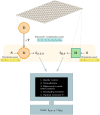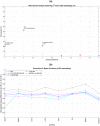COMBSecretomics: A pragmatic methodological framework for higher-order drug combination analysis using secretomics
- PMID: 32407402
- PMCID: PMC7224510
- DOI: 10.1371/journal.pone.0232989
COMBSecretomics: A pragmatic methodological framework for higher-order drug combination analysis using secretomics
Abstract
Multi drug treatments are increasingly used in the clinic to combat complex and co-occurring diseases. However, most drug combination discovery efforts today are mainly focused on anticancer therapy and rarely examine the potential of using more than two drugs simultaneously. Moreover, there is currently no reported methodology for performing second- and higher-order drug combination analysis of secretomic patterns, meaning protein concentration profiles released by the cells. Here, we introduce COMBSecretomics (https://github.com/EffieChantzi/COMBSecretomics.git), the first pragmatic methodological framework designed to search exhaustively for second- and higher-order mixtures of candidate treatments that can modify, or even reverse malfunctioning secretomic patterns of human cells. This framework comes with two novel model-free combination analysis methods; a tailor-made generalization of the highest single agent principle and a data mining approach based on top-down hierarchical clustering. Quality control procedures to eliminate outliers and non-parametric statistics to quantify uncertainty in the results obtained are also included. COMBSecretomics is based on a standardized reproducible format and could be employed with any experimental platform that provides the required protein release data. Its practical use and functionality are demonstrated by means of a proof-of-principle pharmacological study related to cartilage degradation. COMBSecretomics is the first methodological framework reported to enable secretome-related second- and higher-order drug combination analysis. It could be used in drug discovery and development projects, clinical practice, as well as basic biological understanding of the largely unexplored changes in cell-cell communication that occurs due to disease and/or associated pharmacological treatment conditions.
Conflict of interest statement
The authors have declared that no competing interests exist.
Figures






Similar articles
-
COMBImage2: a parallel computational framework for higher-order drug combination analysis that includes automated plate design, matched filter based object counting and temporal data mining.BMC Bioinformatics. 2019 Jun 4;20(1):304. doi: 10.1186/s12859-019-2908-0. BMC Bioinformatics. 2019. PMID: 31164078 Free PMC article.
-
Potential of metabolomics in preclinical and clinical drug development.Pharmacol Rep. 2014 Dec;66(6):956-63. doi: 10.1016/j.pharep.2014.06.010. Epub 2014 Jun 24. Pharmacol Rep. 2014. PMID: 25443721 Review.
-
Automated analysis of routinely generated preclinical pharmacokinetic and pharmacodynamic data.J Bioinform Comput Biol. 2014 Jun;12(3):1450010. doi: 10.1142/S0219720014500103. Epub 2014 Mar 6. J Bioinform Comput Biol. 2014. PMID: 24969748
-
pseudoQC: A Regression-Based Simulation Software for Correction and Normalization of Complex Metabolomics and Proteomics Datasets.Proteomics. 2019 Oct;19(19):e1900264. doi: 10.1002/pmic.201900264. Epub 2019 Sep 18. Proteomics. 2019. PMID: 31474000
-
[Development of antituberculous drugs: current status and future prospects].Kekkaku. 2006 Dec;81(12):753-74. Kekkaku. 2006. PMID: 17240921 Review. Japanese.
References
Publication types
MeSH terms
Substances
LinkOut - more resources
Full Text Sources

